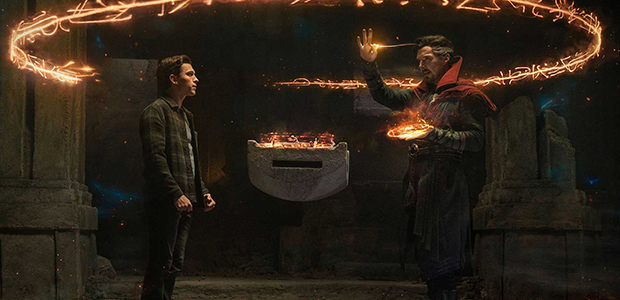
Spider-Man: No Way Home can best be described as simultaneously both a best of album and a remix. By now, you know (or should) what it’s about (there’s no way anyone could have missed the omnipresent trailers). It pulls in villains from the previous films in the franchise, barring the last two, by dipping into the concept of the multiverse and temporal portals by way of some Doctor Strange magic. Who needs new villains when the old one’s still have some flame in them? Equally, who needs to wait for a Sinister Six film – this one fulfills that obligation pretty darn well.
Credit the success of the stupendous Spiderman animated film Into the Spiderverse for prepping us to the possibilities of what such as concept could deliver. And deliver it does. From fan service to monumental moments of elated triumph and heartbreaking tragedy, this trilogy title has it all.
No Way Home works as well as it does because it is built on a foundation of situations and setups that make it relatable. Even before we get to the superhero stuff, which happens very quickly, it weaves one believable predicament after another caused by the ripple effects of Spiderman’s alter ego no longer being a secret identity. During these early portions, it is also appropriately told from the age and perspective of its three main leads – the importance of being accepted into a credible college, the value (and burden) of secrets between friends, that burning desire for the status quo to be maintained while everything changes. And when the plethora of villains start popping up one by one, the film becomes both a retcon of previous mistakes (improving Jamie Foxx’s Electro for e.g.) and a sequel (continuing the story right after the end of Far From Home), sometimes even giving new meaning to old and oft-repeated dialogues and phrases and expanding the lore.
Perhaps what’s most remarkable is how, despite the burden of the tale’s darkness (messing around with other worlds doesn’t make for happy encounters), the humor is deft and used at the service of the story – moving it forward, peppering it with the (much needed) variety of emotional complexity. In somewhat of a unique twist, the script has a lot of fun by letting the audience remain one step ahead of its characters. While some of them are bewildered by what is happening to them and what they are experiencing, we watch as sage observers knowing exactly the what and the how. In this way, it takes the concept of sharing a cinematic experience to unique and somewhat fantastical highs. One scene, in particular, set in the so-called mirror dimension, is both memorable and visually awe-inspiring for being a literal kaleidoscope of moving structures impossibly attacking its inhabitants even while balancing their presence in it. It’s hard to describe, but very easy on the eyes with visual flair and dazzling CGI’s put to great use.
All of this is bold in ways we’ve come to expect from the MCU, but this film isn’t just for fans of the Marvel Cinematic Universe rendition of the character, but also those that have grown watching and adoring the world-building and various character incarnations before it. The film will no doubt pull in the crowds, probably break a few box-office records, but really, it’s a thank you to loyal fans and a payoff for nearly 2 decades of cinematic investment. We’ve earned it.
Rating: 



